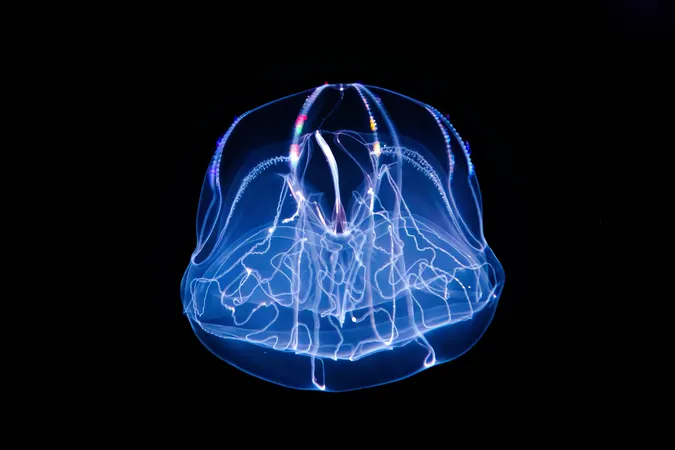
The Bizarre Healing Powers of Comb Jellies: Nature's Own Regenerative Superheroes!
2024-10-08
Author: Jia
Introduction
Comb jellies, or ctenophores, hold a fascinating position among the most extraordinary life forms on our planet. Having graced Earth's oceans for over half a billion years, these ethereal creatures captivate with their translucent bodies and rows of mesmerizing cilia that allow them to glide through water like living specters. Yet, it’s their incredible ability to heal and regenerate that truly sets them apart.
Regenerative Powers of Comb Jellies
Recent research has revealed that comb jellies possess a remarkable capability: when injured, they can not only regenerate lost parts but can also integrate body parts from other injured ctenophores into their own. This fusion process is so seamless it calls to mind the fantasy game "Elden Ring," where players encounter creatures that undergo transformation and integration.
Research Breakthroughs
Dr. Kei Jokura, a marine biologist at the University of Exeter, first stumbled upon this phenomenon while conducting research in a seawater tank filled with these unique specimens. He discovered a particularly large comb jelly that exhibited anatomical features from not one, but two individuals, a rare occurrence of fusion. "Initially, I thought we had discovered something entirely new, a concept that had not been documented before," Jokura remarked.
Historical Context
However, historical context revealed that this wasn't entirely uncharted territory. Back in 1937, B.R. Coonfield from Brooklyn College had conducted similar grafting experiments, showcasing the anatomical symmetry in ctenophores. Yet, while Coonfield noted the potential for grafting, Jokura's team has shifted focus toward understanding the implications of these integrations and whether the surviving fused jellies can function collectively.
Groundbreaking Experiments
In a groundbreaking set of experiments, Jokura and his colleagues took ten pairs of healthy ctenophores and initiated their fusion by closely aligning their bodies. This brave endeavor led to the merging of their membranes, followed by syncing their nervous systems and muscle contractions. Remarkably, after just 30 minutes, the individual ctenophores began to coordinate their movements, achieving 100% synchronization after two hours! However, it was noted that their digestive systems remained independent, suggesting limitations in the fusion process.
The Fusion Success Rates
Nine out of the ten pairs successfully merged, documented through time-lapse photography capturing this evolutionary spectacle. The only failure was linked to potential dysfunction in the regeneration systems of the individuals involved, highlighting the complex interplay of biology at work within these creatures.
Evolutionary Speculations
Experts speculate about the evolutionary advantages behind this unique fusion ability. Ctenophores lack sophisticated allorecognition systems that differentiate self from non-self—an adaptation that could explain their capacity to merge without the rejection commonly seen in higher organisms, such as humans. This simplicity in biological structure may allow them to integrate distinct tissues more readily compared to more complex life forms.
Survival Mechanism?
Another theory is that this fusion capability could serve as a survival strategy, aiding badly injured ctenophores in overcoming grave threats by joining forces. However, researchers like Dr. Marianna Rodriguez-Santiago of Colorado State University suggest that such encounters in the wild are rare due to their solitary nature, making this concept less likely.
Conclusion
As scientists continue to explore the enigmatic world of comb jellies, the ultimate question remains: Is their fusion ability a quirky evolutionary trait or a crucial survival mechanism? For now, the mystery persists, capturing the imagination of both researchers and enthusiasts alike. What other astonishing secrets does the enigmatic comb jelly hold? Stay tuned!


 Brasil (PT)
Brasil (PT)
 Canada (EN)
Canada (EN)
 Chile (ES)
Chile (ES)
 España (ES)
España (ES)
 France (FR)
France (FR)
 Hong Kong (EN)
Hong Kong (EN)
 Italia (IT)
Italia (IT)
 日本 (JA)
日本 (JA)
 Magyarország (HU)
Magyarország (HU)
 Norge (NO)
Norge (NO)
 Polska (PL)
Polska (PL)
 Schweiz (DE)
Schweiz (DE)
 Singapore (EN)
Singapore (EN)
 Sverige (SV)
Sverige (SV)
 Suomi (FI)
Suomi (FI)
 Türkiye (TR)
Türkiye (TR)